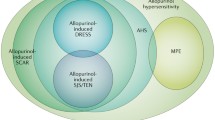Abstract.
Objective: Calcium dobesilate is used in the treatment of diabetic retinopathy, chronic venous insufficiency, haemorrhoids and other ill-defined vascular conditions. It has been associated with agranulocytosis in anecdotal reports. We describe the clinical course of a series of patients who developed agranulocytosis while taking this drug, and we estimate the risk by means of both a case-control and a case-population strategy. Methods: All cases of agranulocytosis meeting strict predefined diagnostic criteria in an area of 3.3 to 3.9×106 inhabitants in the period 1980–1998 were identified. Cases and age-, gender- and hospital-matched controls were interviewed with a structured questionnaire including a detailed drug history. Each case was reviewed and confirmed by a haematologist, who was blind with respect to drug exposures. Consumption data were used to estimate the risk of agranulocytosis associated with calcium dobesilate using a case-population approach in which the incidence of agranulocytosis among users of calcium dobesilate was compared with that among the non-exposed population. Results: After a follow up of 68.55×106 person-years, 345 cases of agranulocytosis (242 community cases) were assembled. Reliable information was obtained from 216 cases. Two patients exhibited positive rechallenge. Twelve cases (5.6%) and 5 of 1380 controls (0.4%) had taken calcium dobesilate in the week before. With the case-control approach, the odds ratio was 23.66 [95% confidence interval (CI), 7.54–74.24], the attributable risk was 5.3% (95%CI, 3.0–9.4), and the number of cases attributable to dobesilate in the study area during the study period was 12.8. The case-population estimates were an incidence of 121.03 cases per 106 patient-years, a relative risk of 39.55 (95%CI, 17.96–77.49), an attributable risk of 6.73% (3.4–12.9%), and 16.30 cases attributable to dobesilate in the study area during the study period. Discussion: This study adds to evidence indicating that the case-population method is adequate for the study of rare type B adverse drug reactions. An additional advantage of this approach is that the incidence of the disease of interest among those exposed to the drug can be estimated. The risk of agranulocytosis associated with calcium dobesilate should be considered in relation to poor evidence of its clinical efficacy.
Similar content being viewed by others
Author information
Authors and Affiliations
Additional information
Accepted in revised form: 5 July 2000
Electronic Publication
Rights and permissions
About this article
Cite this article
Ibáñez, L., Ballarín, E., Vidal, X. et al. Agranulocytosis associated with calcium dobesilate. Eur J Clin Pharmacol 56, 763–767 (2000). https://doi.org/10.1007/s002280000190
Received:
Published:
Issue Date:
DOI: https://doi.org/10.1007/s002280000190




